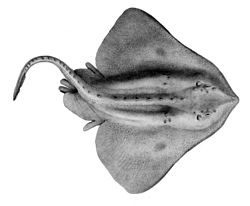| Arctic skate | |
|---|---|
 | |
| Scientific classification | |
| Kingdom: | Animalia |
| Phylum: | Chordata |
| Class: | Chondrichthyes |
| Subclass: | Elasmobranchii |
| Order: | Rajiformes |
| Family: | Rajidae |
| Genus: | Amblyraja |
| Species: | A. hyperborea |
| Binomial name | |
| Amblyraja hyperborea (Collett, 1879) | |
The Arctic skate (Amblyraja hyperborea) is a species of fish in the family Rajidae. It lives near the seabed between 140 and 2,500 m deep in the Arctic Ocean and waters around Canada and northern and north-western Europe, in the northern Pacific Ocean, and in waters surrounding Antarctica and New Zealand. [2]
Contents
The Arctic skate is about 1 m long and is gray-brown with large dark spots. Its underside is white with dark patterns. It has thorns in line from back to near the end of its tail. It is oviparous; its eggs are capsules with hard horns on each corner. It eats all sorts of small animals at the bottom of the sea. [2]
